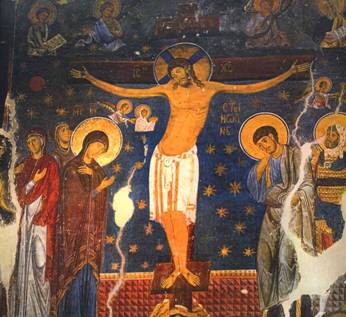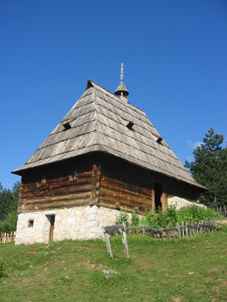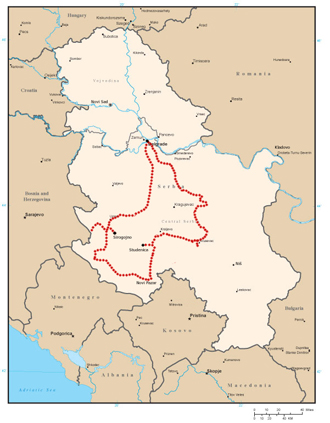MONASTERIES and WESTERN SERBIA - from Belgrade
|
Day 1: Departure Belgrade - Monastery Manasija – Monastery Ravanica - Lazarica Church - Monastery Ljubostinja - Monastery Žiča – Monastery Studenica UNESCO
|
Detailed Itinerary
Day 1: Belgrade – Manasija – Ravanica - Lazarica - Ljubostinja - Žiča - Studenica
We will leave Belgrade in the morning by driving south into the area of central Serbia. Our first visit will be Monastery Manasija, founded by Despot Stefan Lazarević in the first half of the 15th century. This monastery has the best preserved medieval fortification in the country. Its high defensive walls were once additionally protected by 12 towers and a series of hanging machicolations. This fortified area still contains the ruins of the old Refectory, the reconstructed monastic residence with a valuable private library, and the Church of the Holy Trinity with its exceptionally fine fresco paintings.
 A short scenic drive away is Monastery Ravanica, founded by the Serbian Prince Lazar in the second half of the 14th century. This is the most typical example of what is called the Morava School of Serbian medieval architecture. The monastery's five-domed Church of the Ascension displays rather badly damaged but very fine frescoes. A transparent coffin in the church contains relics of the great and highly devoted Prince Lazar, killed in the Battle of Kosovo in 1389 and soon afterwards declared a saint.
A short scenic drive away is Monastery Ravanica, founded by the Serbian Prince Lazar in the second half of the 14th century. This is the most typical example of what is called the Morava School of Serbian medieval architecture. The monastery's five-domed Church of the Ascension displays rather badly damaged but very fine frescoes. A transparent coffin in the church contains relics of the great and highly devoted Prince Lazar, killed in the Battle of Kosovo in 1389 and soon afterwards declared a saint.
We will continue our drive south to the town of Kruševac, the medieval capital of Serbia during the time of Prince Lazar in the second half of the 14th century. We will see the Lazarica Court Church, founded by the Serbian Prince Lazar in 1380. This church represents a fine architectural achievement, adorned with rich carved stone decoration on the arches, rosettes, windows and portals. As one of the earliest monuments of the Morava school, it long served as a model for Serbian builders.
Our next visit will be Monastery Ljubostinja founded by Prince Lazar's wife, Princess Milica in 1388. Its Church of Virgin Mary is considered to be one of the most elegant architectonic monuments of mediaeval Serbia: the domed building, situated in a very pleasant environment, displays the form of an inscribed cross combined with a trefoil. This is maybe the only Serbian monastery where the names of both the chief builder and painter have been preserved.
A short drive away in the town of Kraljevo we will visit Monastery Žiča, founded by the Serbian King Stefan, "the First-Crowned", at the beginning of the 13th century. Its Church of the Ascension served as the first see of the independent Serbian Archbishopric and played a very important role in the religious, political and cultural life of medieval Serbia. The architecture of Monastery Žiča, which has undergone considerable changes, belongs to the oldest School of Serbian medieval architecture. The interior fresco decoration dates from various periods.
Overnight in the Monastery Studenica “Special“ (D)
Day 2: Studenica - Sopoćani - Mileševa – Sirogojno Ethno Village – Zlatibor
We start our day by visiting Monastery Studenica (UNESCO site), founded by Stefan Nemanja. This is considered to be the crowning achievement of medieval culture and art in Serbia. The monastic complex consists of the fascinating Church of the Virgin (1183 - 1196), the Church of SS Joachim and Anne (also known as the King's Church) and the Church of St. Nicholas, a simple single-nave building. The monastery circle contains monuments raised over a period of 130 years, and several Serbian rulers had a hand in their construction. At the start of this period, the young Serbian feudal state under Stefan Nemanja was consolidating its independence, and by King Milutin's reign it had reached the height of its political, cultural and economic power. The strengthening of the medieval state and of its ruler's might is naturally reflected in these monuments.
 Our drive south will take us to the oldest Christian temple in Serbia, Peter’s Church (Petrova crkva), the place where the story of Serbian Monasteries begins. It is believed that the church was built sometime in the 6th or 7th centuries AD. It is an established fact that it was an important spiritual center at the time of Stefan Nemanja, the founder of the illustrious Nemanjići dynasty in the 12th century.
Our drive south will take us to the oldest Christian temple in Serbia, Peter’s Church (Petrova crkva), the place where the story of Serbian Monasteries begins. It is believed that the church was built sometime in the 6th or 7th centuries AD. It is an established fact that it was an important spiritual center at the time of Stefan Nemanja, the founder of the illustrious Nemanjići dynasty in the 12th century.
Our next stop will be one of the most treasured sacral buildings of the Nemanjići era, the Monastery Sopoćani. It is an endowment of King Uroš from the 13th century, and its mural painting ranks among the most magnificent and beautiful in European medieval art. The monumentality of Monastery Sopoćani frescos, the harmony of colors, and the refinement of expression were all responsible for being granted a place on UNESCO’s World Heritage list.
Our last visit will be to the Monastery Mileševa, another jewel of the age of Nemanjići. It was built by King Vladislav in the early 13th century. The church is dedicated to the Ascension of Our Lord and is one of the most beautiful and glorious sacral buildings. Mileševa’s mural is world renowned. This church boasts Serbia’s best-known fresco, a masterpiece of late medieval painting known as The White Angel.
Continuing our journey we will ascend to Mount Zlatibor, one of the most popular mountain resorts in Serbia, both in summer as well as winter. Zlatibor is a National Park famous for its beauty and intact nature. It is a mountain of golden pines, after which it got its name (Zlatan - golden, Bor – pine tree). A short drive through the beautiful countryside will take us into an area where the vegetation will change its look, giving you the impression that you are in a jungle. Here you can find unique flora and fauna, such as the Omorica, the rarest of the pine trees endemic to this area. First we will pay a visit to the unique and very charming ethno village of Sirogojno. It is an open-air museum of traditional architecture, as well as an exhibition of handicrafts and world famous hand-knitted clothes.
Overnight at Sirogojno – Hotel Staro Selo village “Special” B, D)
Day 3: Sirogojno – Šargan Eight Train – Mećavnik – Beograd
This morning we will take a nostalgic journey by the old steam engine “Šarganska Osmica” for 15km, crossing breathtaking scenery through 20 tunnels, 10 bridges and across many viaducts. Once, this narrow gauge train, affectionately known as the Ćira (Chira), used to be the only traveling solution for the people of the area. The train cut its path through the astonishing landscapes of Serbia and Bosnia, on its way from Belgrade to Sarajevo, and further on to Dubrovnik. Now it is possible to ride a 15km part of it, famous for its curves in the shape of the number 8 that made it possible to climb the steep slopes of the mountains Šargan and Mokra Gora. The track was reconstructed in 1999.
During the ride, the train makes a few stops, one of which lasts 20 minutes to let you take some fabulous photographs, enjoy the views, or have a refreshment in the cafe of a tiny and charming 'railway station'.
After the train ride we will pay a visit to the ethno village of Mecavnik, the 'Wooden City', built as a setting for the latest film of the very famous movie director Emir Kusturica. The amazing village was, until recently, merely a couple of salvaged traditional wooden houses on a bluff above a beautiful valley.
Departing back to Belgrade we will first pass trough region of the Gorges of Ovcar and Kablar, where a number of old monasteries were built in Turkish times. Here fervent adherents of the Orthodox Church withdrew to the mountainous, inaccessible, and isolated parts of the country.
In the evening we will return to Belgrade (B)
B – Breakfast L – Lunch D – Dinner
All hotels are carefully chosen for their character or best central location or they are simply the only option at certain destinations. All of them can be changed on a request. The categories mentioned by the hotel names are according to the local standards and sometimes do not reflect to Western standards
Trip organized by: “BALKAN EXPERT” d.o.o. license no. OTP 54/2013
Tour available with general condition of travel of “BALKAN EXPERT”







